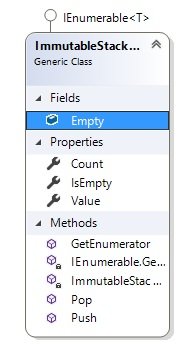Building a fully Immutable Stack in C# - Includes SBD 0.001 puzzle buried in the article :)
Today I will breakdown the implementation of an immutable generic stack in C# 7, with full LINQ integration. I decided to do this after reading some good posts by drifter1 exploring different storage structures in C.
Introduction
I am sure everyone knows what stack based storage is, simple LIFO (Last In First Out) storage that traditionally you "push" new values onto the top of the stack, to get them back off you "pop" them off the top until all the values have been removed.
This is implemented using an immutable linked list, where the head of the stack is the head of the linked list. I decided to go with immutability for a few reasons:
- Complete thread safety if you store immutable data
- The ideal fit for this storage type
- I like immutability :)
The immutability means I had to take one liberty with the normal interface push/pop interface, the reasons for this will become self evident when you see the implementation.

Empty
This is how you create every new list, all stacks you create will share this common base.
var stack1 = ImmutableStack<int>.Empty;
var stack2 = ImmutableStack<int>.Empty;
Push
Adds new values to the stack, when called you get back a new stack with the value on the top. The original stack still exists.
// SBD 0.01 for the first to comment with the book I was thinking of :)
var book = ImmutableStack<int>.Empty.Push(4).Push(2);
var newStack= stack.Push(5);
The book stack still contains 4, 2 while newStack contains 5, 4, 2. The 4, 2 values and storage are shared in both.
Pop
Removes the top of the stack and returns you the new stack with the item removed. This is the break in the normal implementation caused by immutability, I could have gone with a (value, newStack) tuple but felt my work around was cleaner.
// stack just contains the value 10.
var stack = ImmutableStack<int>.Empty.Push(10).Push(20).Pop();
Value
You can look at the top value on the stack using this property
// value = 20
var value = ImmutableStack<int>.Empty.Push(10).Push(20).Value;
IsEmpty
Just tells you if the stack is empty or not
var empty = ImmutableStack<int>.Empty.IsEmpty;
var notEmpty = ImmutableStack<int>.Empty.Push(10).IsEmpty;
Count
The number of values contained in the stack
LINQ
I implemented the IEnumerable interface to provide full LINQ integration
// Prints the following
// Next value is 20
// Next value is 10
foreach (var value in ImmutableStack<int>.Empty.Push(10).Push(20))
{
Console.WriteLine($"Next value is {value}");
}
Implementation
I have tried to keep this as paired down and clean as possible. The various parts should be obvious from the API description.
public class ImmutableStack<T> : IEnumerable<T>
{
public static ImmutableStack<T> Empty
= new ImmutableStack<T>();
private readonly ImmutableStack<T> _stack;
private readonly T _value;
public T Value
{
get
{
if (IsEmpty)
{
throw new Exception("List is empty");
}
return _value;
}
}
public int Count { get; }
public bool IsEmpty => Count == 0;
// Constructors are private to force use of Empty
private ImmutableStack() { }
private ImmutableStack(
T value, ImmutableStack<T> stack)
{
_stack = stack;
_value = value;
Count = stack.Count + 1;
}
public ImmutableStack<T> Push(T value)
=> new ImmutableStack<T>(value, this);
public ImmutableStack<T> Pop()
{
if (IsEmpty)
{
throw new Exception("List is empty");
}
return _stack;
}
public IEnumerator<T> GetEnumerator()
{
var current = this;
while (!current.IsEmpty)
{
yield return current.Value;
current = current._stack;
}
}
IEnumerator IEnumerable.GetEnumerator() => GetEnumerator();
}
Interested in any feedback as always
Woz
Nice one! Good job! :)
Good contents...
I think you did typo error
book.Push(5) means "PUSH 5 on book", so you may think book is (5,4,2)
Actually book.Push(5) returns new stack.
Let's see the expression : ImmutableStack.Empty.Push(4).Push(2);
Stack.Push(4) returns something, that means Stack.Push() doesn't change Stack itself.
If Push() changes the Stack, Push() will return nothing.
This is the common rule of making APIs.
Immutable list comes from LISP (functional programming)
Adding an element in front of the list keeps element-sharing and list-immutability.
That is the nature of immutability, yep, the push returns a new stack with 5 on the head of book, It forks the chain like a fork in blockchain, the 4 2 are common in updated along with the storage infrastructure. I mention this in the notes after that snippet but might not have been clear enough :)
The big mistake people not used to immutability might make is
book.push(5);
thinking book is updated. It has forked as has each call to push. Similar if you make an immutable ATV and change it the original tree is as is and a new copy is built with just the required tree rebuilt :)
If you look after a push/pop I always keep the new returned stack. I am a fan of functional but lisp has too many brackets for me :)
I have edited the name "updated" to read "newStack", I think that is more explicit :)
Just shows how variable names can have a huge impact :)
Nobody has guessed the book yet, the numbers 4 & 2 have not rung a bell will anyone?
I think the book is 2,4 (2 is top) no other guess I can figure out what the book you were thinking of.
I am thinking more about a piece of fiction :)